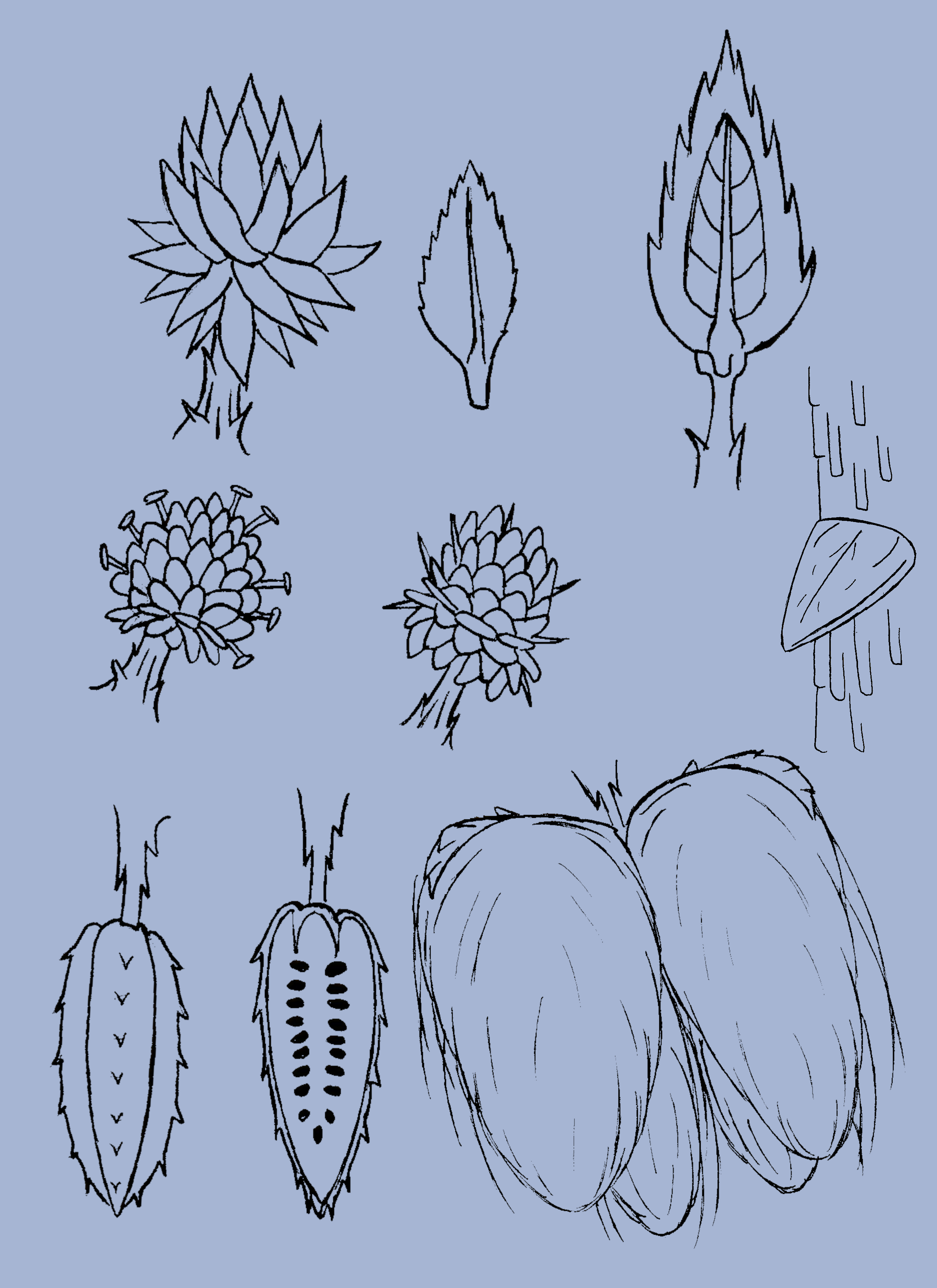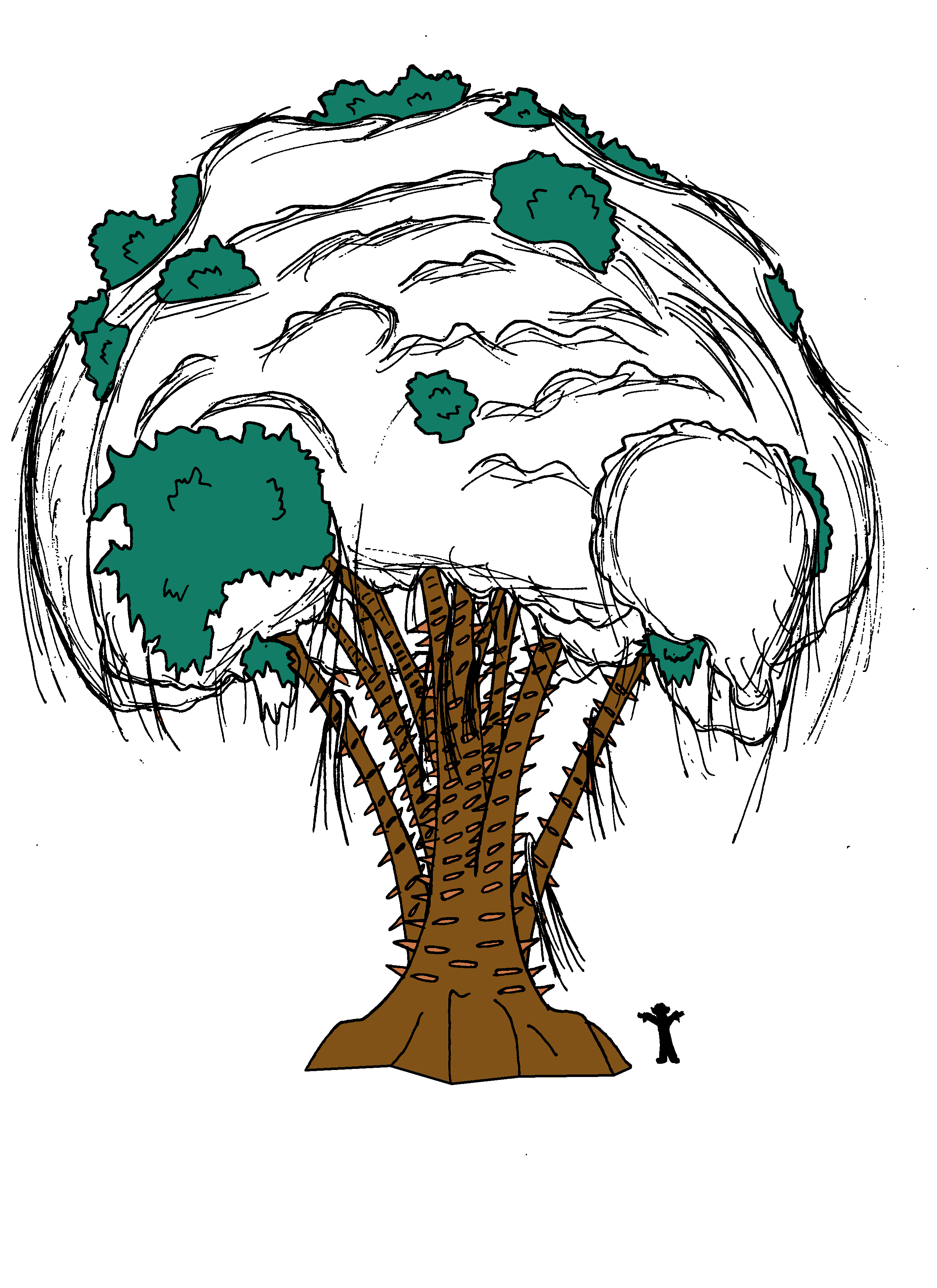Description
Cloud Trees are a large tree that often grow to an average height of 55m. Like other Sphere Trees, they have wide spanning crowns that can be as wide as the tree is tall. They have dense root systems that prevent the growth of competing tree species, and their leaves and cotton cover the ground in shade, often allowing only grasses to grow near them. Cloud Trees take around twenty years to fully mature and flower for the first time. There is no known maximum age limit on this tree. Some trees die after only a hundred years because the cotton fibers from its own seeds accumulate too much on the tree, starving itself of necessary light.
The tree can grow multiple trunks depending on the species. It has a wide flared base for storing large amounts of water and nutrients, though this tree also stores large amounts of oils as well. Its bark is always a pale yellow color.
Leaves
Cloud Tree's are scientificially classified as sphere trees because some species have leaves that grow in a fully spherical pattern, from an enlarged stem. The vast majority of cloud trees sprout a single leaf per stem, which are still enlarged compared to the stems of other plants. It is thought that Cloud Trees were an early divergence from other sphere tree varieties and this occured just over a hundred million years ago.
Like most sphere trees, new leaves will sprout red or purple in color and mature leaves will be green to slightly blue on the sunward side and green on the shaded side.
Along the main trunk and larger branches, modified leaves grow directly with no obvious stem. These leaves are stiff and resemble thorns or spines. These spines are also quite large and sturdy, enough to offer hand and footholds for Regalti brave enough to climb these trees. In the distant past, these spines evolved to protect the tree from large climbing herbivores. These herbivores are mostly extinct outside the savannahs of Falthin.

Leaf and Flower Detail by Chrispy_0
Sap
The sap of cloud trees is rather oily and smells faintly of ethanol, which has caused some Regalti to attempt to consume large amounts of the sap, only to get sicker than drunk. The sap does have properties useful to them, but is useful in much smaller amounts. It is also quite flammable.

Cloud Tree, Covered in Cotton by Chrispy_0
Flowers
Cloud Trees flowers are always pale green in color, though female flowers are noticeably brighter. The flowers are also spherical looking, with mostly short petals sticking out of an enlarged area at the end of a stem, similar to its leaves. Pollen can spread by wind, but is most often done with flying insects. Other flying creatures such as
Kiurnal avoid this tree.
Cloud Trees are one of the few plants on Collena that has entirely male and female trees instead of a single tree sharing male and female flowers. This is different from other Sphere trees that flower Male and Female flowers at the same time or rarely at different times of the year.
Seeds and Seed Pods
The seeds of wild Cloud trees are protected by an 8 to 10cm shell of fluffy, slightly flammable, greenish fibers, made mostly of cellulose. These seed pods can hold several dozen seeds. When the shell breaks the fluffy fibers expand to roughly ten times the size of the original seed pod, creating a large puffy ball of cotton around 30cm across. Domesticated Cloud Trees were bred so their seed pods are larger and contain considerably more cotton fibers. These can be 25 to 30 cm across and burst open to a meter or more. The seeds themselves are covered in tiny hairs and will spread by wind much in the same way as other sphere trees.
Around 95% of the fibers will gradually degrade over the course of six months, being consumed by insects and fungi. Some animals will also eat the fibers. The remaining 5% is considerably tougher and stays on the tree for up to a decade, gradually accumulating more and more fibers until the entire tree is covered. These fibers are completely white and are what gives older trees their cloud-like appearance.
A large number of animals will take refuge in the cotton. smaller animals like the
Srakaels and
Galin will build nests and take refuge during the winter months. Some arthropods like the collosal
Bataiva will also build nests in the tree, adding their own silk to the cotton to make the nest stronger and water resistant. The Bataiva will also hide in the cotton to stage ambushes on animals foraging on the ground below, not to eat these animals, but to scare them away so these animals don't accidentally step on or eat the Bataiva's young.
Pests, Disease, Defense
Pests
The tree itself is generally safe from infections from fungi or from insects, but bacterial and viral infections are common. There is the issue of its seed pods being consumed before they burst open and allow the seeds to spread. On the Savannah, a number of large animals occasionally eat the seed pods. Smaller animals like the Srakael will pick and hoard the seed pods in nests it built in the cotton fibers.
Disease immunity
Like many large plants on Collena, Cloud Trees have evolved an immune system in a symbiotic relationship with phagocytic microbes. Also known as
Chlorophages, it acts very much like the immune system in animals. If the tree has an especially bad infection, it will make toxic chemicals in its sap that kills everything, including its own immune cells. The Chlorophages release poison reistant spores in response to this so they can continue on once the toxins are flushed from the plant's system.
Other Defenses
Cloud Tree Seeds are quite toxic to most animals, but only every four or five years, depending on species. It isn't really known why this is. Some smaller animals like Srakael and Galin have evolved immunity to this poison. Normal seeds are dark, almost black. Poisonous seeds are almost white, but only under UV light, and they have a faint smell of acetone. This allows some animals such as
Hysovi to tell the difference who otherwise regularly graze on the cotton fibers.
Savannah dwelling species evolved the ability to grow to 55 meters or more to literally grow out of reach of the large herbivores. The issue is that these species also tend to have multiple smaller trunks, so some animals will just rip the whole tree down to eat it. The species that grow in the warm oceanic climates tend to be shorter, from 10 to 25 meters in height.
Uses
Sap
Due to the flammability of the sap, early Regalti would break off Cotton Tree Branches, then cut into the tree and soak the cotton fibers in the sap. Once set on fire, they can make a torch that will last up to 2 hours. The Sap also acts as a strong anti-septic and can be used to treat wounds. It has anti-bacterial and anti-fungal properties and can be consumed in small amounts to treat digestive issues.
Cotton
The Cotton harvested from Cloud Trees has been woven into fabric for thousands of years. Numerous cultures use this fabric. The Fevarik Regalti make the majority of their Traditional Robes out of this material.
Actually harvesting the cotton fiber from a naturally growing tree is somewhat difficult because of all the animals that live in it, the seeds, the flammable nature of the tree, and other issues. The trees on farms are different from wild trees and have been selectively bred for as long as Regalti have been using them to be make the fibers undesirable for animal habitation and to make the fibers more flame resistanct. Experiments have been conducted on growing Cloud Trees in space, but have failed because the tree doesn't survive well in low gravity environments.
Spines
The Spines on particularly large cloud trees were fashioned into various tools by ancient regalti, ranging from shovels to picks and more. The Spines can also be used for things such as flower pots, cups, bowls and plates, depending on how it was hollowed out. Especially large spines are hollowed out and driven into the ground and then used to collect rain water. Rare examples of Fevarik armor show the spines being tied together to make a sort of scale armor.
In Modern times, wood workers still harvest spines from cloud trees and fashion them into various wooden objects. Then they are shipped to space for the much larger population of Stellar Regalti to purchase.
Bataiva Gardens
Bataiva are unsettling to some Regalti (and most other intelligent species) because a spider is still kind of scary no matter if it's actually a spider or not, no matter how big or small, feroucious or docile, helpful or not.
Some Regalti cultures use the spiders to grow gardens of fungi and plants for them. The Regalti will pick through the tree to remove pests to make the Bataiva see Regalti as helpful. Regalti will present the Bataiva with "gifts" of various seeds and spores of plants and fungi. The Bataiva grows the plants and fungi in its gardens, and then trade some of those fully grown plants and fungi for more seeds and spores. As Bataiva have the intelligence of a young teenager so it can be reasoned with and understands speech, though it's own noises that might count for speech are hardly understandable to all but the Reglati that lived around them the longest.
Extras
(coming soon)





Comments
Author's Notes
Images are works in progress and are solid colors or lines for now, but they should give you an idea of the look of the plant.
Kapok Trees https://en.wikipedia.org/wiki/Ceiba_pentandra
Red Cotton Trees https://en.wikipedia.org/wiki/Bombax_ceiba
Tree Cotton (just a tall shrub) https://en.wikipedia.org/wiki/Gossypium_arboreum
There are actually several examples of Cotton trees on Earth, though none of them have so much cotton fibers that it covers the entire tree like Cloud Trees do:
Also, I think I need to start actually working on the fundamentals for a Regalti/Fevarik language soon. I've made up at least a thousand words and it's all pretty much made up nonsense...